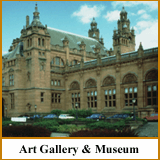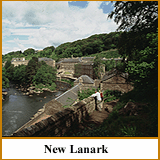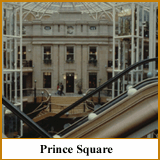

 |
 |
|
|
|
|
South
of Scotland
| West Highlands & Islands, Loch
Lomond, Stirling & Trossachs |
Perthshire, Angus & Dundee and Kingdom of Fife | The
Highlands of Scotland | Grampian
Highlands, Aberdeen & North East Coast | The
Outer Islands - Orkney, Shetland and Western Isles | Edinburgh
- City, Coast and Countryside | Greater
Glasgow & Clyde Valley
|
|||
| GREATER
GLASGOW & CLYDE VALLEY |
||||
| The gateway to Scotland, Glasgow is one of Europe's great cultural destinations. Its museums and galleries are complemented by beautiful countryside along the River Clyde from its source, through garden valleys and on to the sea. | ||||
|
Today's Glasgow is letting the world know about its striking architecture, heritage and culture, building on the success of a string of culturally orientated visitor attractions as well as accolades like Cultural Capital of Europe in 1990 and UK City of Architecture and Design in 1999. Typical of the city's attractions is the Gallery of Modern Art. Housed in a handsome neoclassical building in the city centre, the gallery displays some fine examples of Scottish figurative art, though there is also an eclectic collection from all parts of the world. The material on each floor reflects one of the four elements of fire, air, earth or water and there are also a number of interactive exhibits. Glasgow is the headquarters of many artistic companies, including Scottish Opera, Scottish Ballet and the Royal Scottish National Orchestra, all of which have regular concert programmes in custom-built halls, most notably the prestigious Glasgow Royal Concert Hall. Britain's largest community festival, Mayfest, is held each May and encompasses a whole range of visual and performing arts. THE LOCAL ANGLE Glasgow's culture is far more than high art. It embraces the heritage of the ordinary citizen at places like The Tenement House, where a typical city dwelling of the recent past is open to view. It also includes the People's Palace, where the social history of Glasgow is told. Outside the city, the Paisley Museum and Art Gallery portrays the development of the famous and distinctive Paisley shawl, while the McLean Museum in Greenock also focuses on social history. THE RIVER
CLYDE West of Glasgow, where the Clyde opens out in an ever widening estuary is Inverclyde, overlooking popular cruising waters with a backdrop of the hills of Argyll. Among its many attractions is the Clyde Muirshiel Country Park, with its moor and woodland scenery. With dramatic ruined castles, industrial heritage, country parks and also the Hamilton Mausoleum (boasting Europe's longest echo at 22 seconds), the River Clyde valley has much to offer. SHOPPING The area known as Merchant City, which recalls the entrepreneurs who traded with the Americas is the 18th and 19th centuries, is now a district of small, select shops. Notable here is the Italian Centre, a concentration of Italian fashion designer shops in a conversion of a handsome Merchant City building. By contrast, The Barras near Glasgow Green is part flea market, part entertainment and very much an integral part of Glasgow Life. NIGHTLIFE Glasgow is famous for its variety of pubs, wine bars and other places of much conviviality, where visitors will find Glasgow hospitality at its best. Many of the city's pubs offer live entertainment in the form of folk or jazz. From wholesome pub food to more exotic cuisine, Glasgow's restaurant scene is both lively and cosmopolitan. Clubs and nightspots are up-to-date and fashion conscious and often feature live bands. There is also a thriving and authentic Ceilidh scene, where Scotland's native music can be enjoyed. For a complete guide to the city's entertainment, visitors should call in to the city's Tourist Information Centre. |
||||
|
 The
Burrell Collection, with its collection of textiles, furniture,
ceramics and other objets d'art, is also typical of the city's cultural
wealth. The Art Gallery and Museum in Kelvingrove Park is
one of Europe's finest civic art collections. Opposite is the Museum
of Transport, with re-constructions of a typical Glasgow street
of the 1930's. Also nearby is the Hunterian Museum and Art Gallery,
where the work of Charles Rennie Mackintosh is well represented. The Mackintosh
House within the gallery comprises an accurate reconstruction
of the interiors of one of his former homes. To the east of the city centre,
located next to Glasgow Cathedral, is the stimulating St
Mungo's Museum of Religious Life and Art, presenting the universal
themes of life, death and the hereafter through evocative art associated
with different religious faiths.
The
Burrell Collection, with its collection of textiles, furniture,
ceramics and other objets d'art, is also typical of the city's cultural
wealth. The Art Gallery and Museum in Kelvingrove Park is
one of Europe's finest civic art collections. Opposite is the Museum
of Transport, with re-constructions of a typical Glasgow street
of the 1930's. Also nearby is the Hunterian Museum and Art Gallery,
where the work of Charles Rennie Mackintosh is well represented. The Mackintosh
House within the gallery comprises an accurate reconstruction
of the interiors of one of his former homes. To the east of the city centre,
located next to Glasgow Cathedral, is the stimulating St
Mungo's Museum of Religious Life and Art, presenting the universal
themes of life, death and the hereafter through evocative art associated
with different religious faiths. A
little further afield, New Lanark is just one of a whole range of fascinating
visitor attractions easily accessible off the main artery of the A74 /
M74. Close to the town of Lanark, the River Clyde flows through a wooded
rocky gorge, famed for its outstanding beauty. The river here formerly
powered textile mills in a development controlled by the enlightened industrialist
Robert Owen. The doctrine of Owenism, with its Utopian ideas of workers'
welfare, later became famous the world over and the New Lanark Visitor
Centre tells the story.
A
little further afield, New Lanark is just one of a whole range of fascinating
visitor attractions easily accessible off the main artery of the A74 /
M74. Close to the town of Lanark, the River Clyde flows through a wooded
rocky gorge, famed for its outstanding beauty. The river here formerly
powered textile mills in a development controlled by the enlightened industrialist
Robert Owen. The doctrine of Owenism, with its Utopian ideas of workers'
welfare, later became famous the world over and the New Lanark Visitor
Centre tells the story. Naturally,
a major city such as Glasgow offers a very wide choice of shopping options,
notably around Buchanan Street, Argyle Street
or Sauchiehall Street. In addition, while the St Enoch Centre
represents the modern trend in covered shopping and is one of the largest
malls in Europe, Princes Square adds an elite note, with a sophisticated
ambience appropriate for a style-conscious city.
Naturally,
a major city such as Glasgow offers a very wide choice of shopping options,
notably around Buchanan Street, Argyle Street
or Sauchiehall Street. In addition, while the St Enoch Centre
represents the modern trend in covered shopping and is one of the largest
malls in Europe, Princes Square adds an elite note, with a sophisticated
ambience appropriate for a style-conscious city.